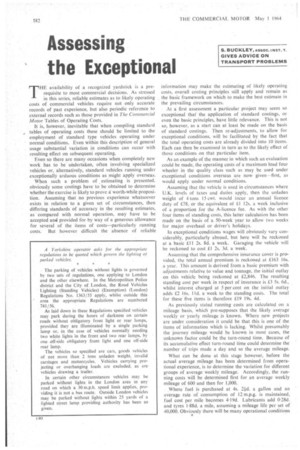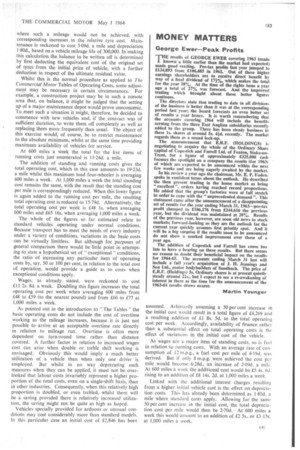Assessing the Exceptional
Page 184

Page 185

If you've noticed an error in this article please click here to report it so we can fix it.
THE availability of a recognized yardstick is a prerequisite to most commercial decisions. As stressed in this series, reliable estimates as to likely operating costs of commercial vehicles require not only accurate records of past experience, but also periodic reference to• external records such as those provided in The Commercial Motor Tables of Operating Costs.
It is, however, inevitable that when compiling standard , tables of operating costs these should be limited to the employment of standard type vehicles operating under normal conditions. Even within this description of general usage substantial variation in conditions can occur with resulting effect on subsequent operating.
Even so there are many occasions when completely new work has to be undertaken, often involving specialized vehicles or, alternatively, standard vehicles running under exceptionally arduous conditions as might apply overseas.
When such a problem of estimating is presented, obviously some costings have to be obtained to determine whether the exercise is likely to prove a: worth-while proposition. Assuming that no previous experience whatsoever exists in relation to a given set of circumstances, then differing standards of accuracy in the resulting estimates, as compared with normal operation, may have to be accepted and provided for by way of a generous allowance for several of the items of costs—particularly running costs. But however difficult the absence of reliable
information may make the estimating of likely operating costs, overall costing principles still apply and remain as the basic framework on which to make the best estimate in the prevailing circumstances.
• At a first assessment a particular project may seem so exceptional thatthe application of standard costings, or even the basic principles, have little relevance. This is not so, however, as a start can at least be made on the basis of standard costings. Then re-adjustments, to allow for exceptional conditions, will be facilitated by the fact that the total operating costs are already divided into 10 items. Each can then be examined in turn as to the likely effect of those conditions on that particular item.
As an example of the manner in which such an evaluation could be made, the operating costs of a maximum load four wheeler in the quality class such as may be used under exceptional conditions overseas are now given—first, as would apply under normal conditions.
Assuming that the vehicle is used in circumstances where U.K. levels of taxes and duties apply, then the unladen weight of 4 tons 15 cwt. would incur an annual licence duty of £78, or the equivalent of 1 12s. a week inclusive of a proportion for the A-licence fee. As with the other four items of standing costs, this latter calculation has been made on the basis of a 30-week year to allow two weeks for major overhaul or driver's holidays.
In exceptional conditions wages will obviously vary considerably, particularly abroad, but here will be reckoned at a basic £11 2s. 8d. a week. Garaging the vehicle will be reckoned to cost £1 2s. 3d. a week.
Assuming that the comprehensive insurance cover is provided, the total annual premium is reckoned at £163 I6s. a year. This amount is derived from a basic premium with adjustments relative to value and tonnage, the initial outlay on this vehicle being reckoned at £2,846. The resulting standing cost per week in respect of insurance is £3 Ss. 6d., whilst interest charged at 5 per cent on the initial outlay adds £2 16s. Ild. a •week to the standing costs. The total for these five items is therefore £19 19s. 4d.
As previously stated running costs are calculated on a mileage basis, which pre-supposes that the likely average weekly or yearly mileage is known. Where new projects are under consideration it could be that this is one of the items of information which is lacking. Whilst presumably the journey mileage would be known in most cases, the unknown factor could be the turn-round time. Because of its accumulative effect turn-round time could determine the number of trips made a day and so the average mileage.
What can be done at this stage however, before the actual average mileage has been determined from operational experience, is to determine the variation for different groups of average weekly mileage. Accordingly, the running costs will be determined first for an average weekly mileage of 600 and then for 1,000.
Where fuel is purchased at 4s. 21d. a gallon and an average rate of consumption of 12 m.p.g. is maintained, fuel cost per mile becomes 4.19d. Lubricants add 0.28d. and tyres 1-88d. a mile, assuming a mileage life per set of
40,000. Obviously there will be many operational conrditions • where such a mileage would not be achieved, with corresponding increases in the relative tyre cost. Maintenance is reckoned to cost 3-09d. a mile and depreciation 1-80d., based on a vehicle mileage life of 300,000. In making this calculation the balance to be written off is determined by first deducting the equivalent cost of the original set of tyres from the initial price of vehicle, with a further deduction in respect of the ultimate residual value.
Whilst this is the normal procedure as applied to The Commercial Motor Tables of Operating Costs, some adjustment may be necessary in certain circumstances. For example, a construction project may be in such a remote area that, on balance, it might be judged that the setting up of a major maintenance depot would prove uneconomic. To meet such a situation it might, therefore, be decided to commence with new vehicles and, if the contract was of sufficient duration, to write them off completely as well as replacing them more frequently than usual. The object of this exercise would, of course, be to restrict maintenance to the absolute minimum, whilst at the same time providing maximum availability of vehicles for service.
At 600 miles a week the total for the five items of running costs just enumerated is 11.24d. a mile.
The addition of standing and running costs gives the total operating cost, which in this case amounts to 19.23d. a mile whilst this maximum load four-wheeler is averaging 600 miles a week. At 1,000 miles a week the total standing cost remains the same, with the result that the standing cost per mile is correspondingly reduced. When this lower figure is again added to the running cost per mile, the resulting total operating cost is reduced to 15-79d. Alternatively, the total operating cost per week is £48 Is. when averaging 600 miles and £65 16s. when averaging 1,000 miles a week.
The whole of the figures so far estimated relate to standard vehicles operating under normal conditions. Because transport has to meet the needs of every industry under a variety of conditions, variations in the basic costs can be virtually limitless. But although for purposes of general comparison there would be little point in attempting to state a hypothetical set of " exceptional " conditions, the ratio of increasing any particular item of operating costs by, say, 50 or 100 per cent, in relation to the total cost of operation, would provide a guide as to costs when exceptional conditions apply.
Wages, as already stated, were reckoned to cost £11 2s. 8d. a week. Doubling this figure increases the total operating cost per week when averaging 600 miles from £48 to £59 (to the nearest pound). and from £66 to £77 at 1,000 miles a week.
As pointed out in the introduction to "The Tables" the basic operating costs do not include the cost of overtime working as the mileage increases, because it is just not possible to arrive at an acceptable overtime rate directly in relation to mileage run. Overtime is often more dependent on turn-round time rather than distance covered. A further factor in relation to increased wages cost can arise when double or treble shift working is envisaged. Obviously this would imply a much better utilization of a vehicle than when only one driver is employed. But whilst in no way deprecating such measures when they can be applied, it must not be overlooked that labour costs invariably represent a higher proportion of the total costs, even on a single-shift basis, than in other industries. Consequently, when this relatively high proportion is doubled, or even trebled, whilst there will be a saving provided there is relatively increased utilization, the saving might not be quite as high as hoped, Vehicles specially provided for arduous or unusual conditions may cost considerably more than standard models. In this particular case an initial cost of £2,846 has been assumed. Arbitrarily assuming a 50 per cent increase in
the initial cost would result in a total figure of £4,269 and a resulting addition of I:1 8s. 5d. to the total operating
cost per week. Accordingly, availability of finance rather than a substantial effect on total operating costs is the effect of variations in the initial cost of the vehicle.
As wages are a major item of standing costs, so is fuel
in relation to running costs. With an average rate of consumption of 12 m.p.g., a fuel cost per mile of 4.19d. was
derived. But if only 8 m.p.g. were achieved the cost per mile would become 6-28d., an increase of 2-09d. a mile. At 600 miles a week the additional cost would be £5 4s. 6d.
rising to an addition of £8 14s. 2d. at 1,000 miles a week.
Linked with the additional interest charges resulting from a higher initial vehicle cost is the effect on depreciation costs. This has already been determined as 1-80d. a mile where standard costs apply. Allowing for the same 50 per cent increase in the initial cost, the total deprecia tion cost per mile would then be 2-70d. At 600 miles a week this would amount to an addition of £2 5s., or £3 15s.
at 1,000 miles a week,




















































































































































































































































